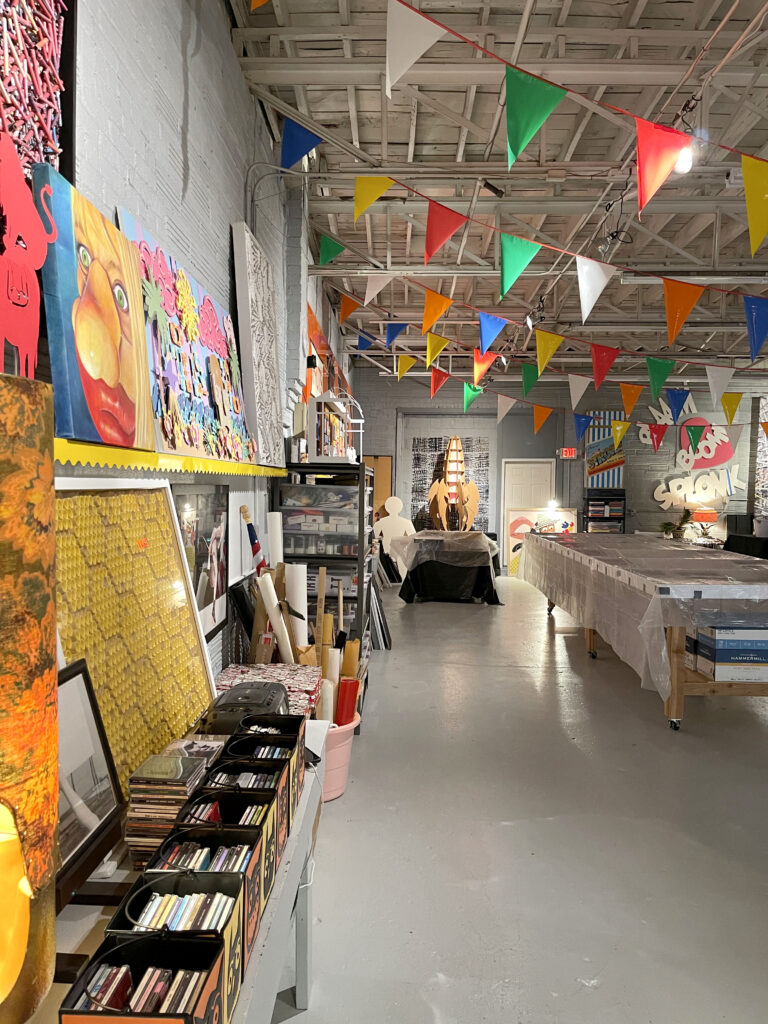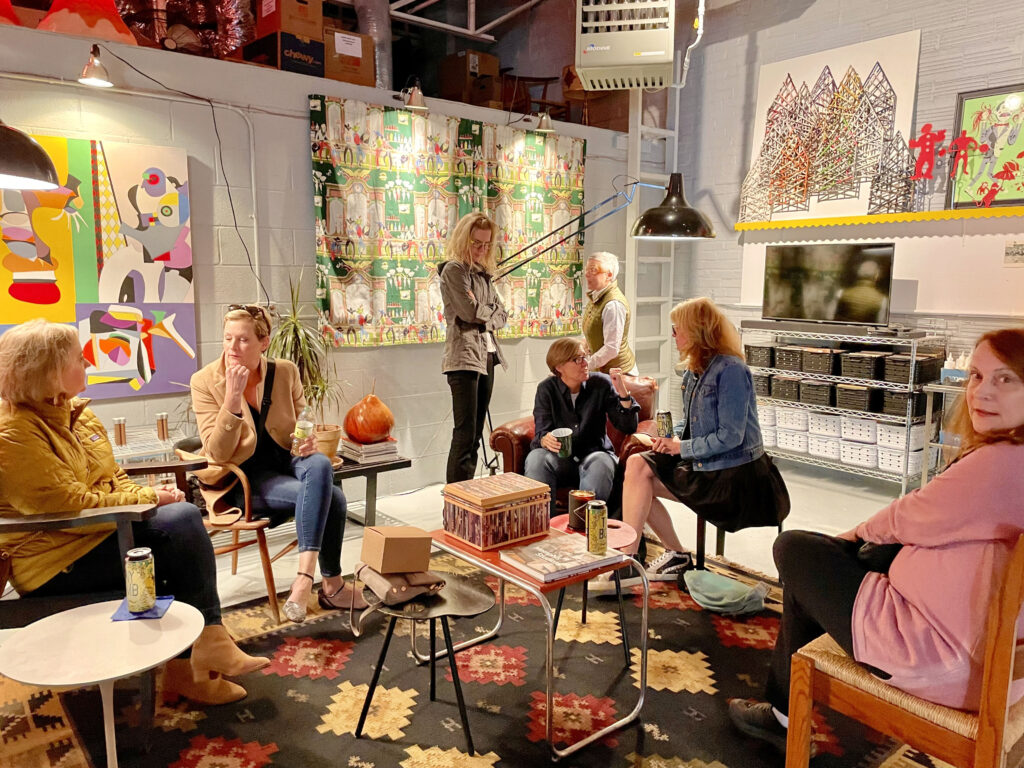(Above: Brantley poses in front of his artwork. The piece commemorates the Methodist LeBonheur Healthcare Centennial. It is hung at Shorb Tower at Methodist University Hospital in Midtown Memphis. Photo courtesy of Lisa Buser.)
I had an opportunity to get to know Brantley Ellzey (he/him) better. If you know him, you know that he is a very interesting person, has great thoughts on architecture and preservation, and is a meticulous artist. We couldn’t let this issue go by without introducing everyone to him. Meet Brantley Ellzey.
Tell us about your journey as an artist. I loved magazines from an early age.
My parents built a house when I was a kid and I poured over the homebuilding and decorating magazines my mom had collected for inspiration. I delighted in my cousin’s Vogue magazines and scoured the waiting room at my dad’s office for magazines left behind. These publications presented a fantasy life removed from my small Arkansas town. They were a refuge for a little gay boy who preferred walking through his imaginary dream house to watching a football game.
This childhood interest in the arts, the built environment, culture and beauty informed my education and continues to inform my career as architect, designer and artist. I’ve been lucky to be able to combine so many varied pursuits into a rewarding art and design practice.
You have a unique style to your artwork using a rolling technique that seems meticulous and is very beautiful. Where did the idea or inspiration of your artwork come from?
Thank you! Rolled paper as an art form has been around for a very long time. Rolled paper beads were very popular in Victorian England. A woman in my hometown of Osceola, Arkansas made handicrafts out of rolled paper that she gave away as gifts. I had a small trash can as a child that she had made out of a paper ice cream bucket covered in rolled paper.
I designed furniture as part of my architecture work in the nineties and originally conceived of rolled paper as a sort of marquetry for furniture pieces. I realized that by rolling the pages I was storing the information contained on them. Rolled paper not only worked as an unusual and beautiful visual but also as a time capsule. This led me to the concept of using a particular printed media source to convey a particular theme in my work.
My current work with rolled paper and the process of making it is a direct progression from my experience in architecture. I have an active mind yet I crave order. I begin a piece with sketches that progress to more exact, detailed drawings. I then move on to collecting materials, processing them (cutting, collating), and then rolling the thousands of pages required for a piece. The rolling process requires concentration and focus. It’s akin to knitting in its meditative quality. Once the rolling is complete, I sort and arrange the rolled pages to form a palette, and then construction begins. Once I’ve begun a piece, there’s really no chance of changing it short of ripping entire sections apart. The work is labor-intensive and time-consuming resulting in pieces that are very structural, planned, and precise while also being theatrical and engaging. I could not be doing the work I am today without my experience in theater, design, and architecture.
What experiences have you had in your artistic journey that have helped you to excel at self-expression outside of creating your artwork?
I’ve been able to work in many different arenas in Memphis that have inspired me and allowed me to exercise my creativity. I’ve designed entire buildings, interiors, installations, exhibitions, and a corporate museum. I’ve done sets for local theaters and acted in several shows. (I met my husband Jim backstage at Theatre Memphis.) I’ve created window displays and party environments and designed and produced greeting cards and gift items. It’s been nice to work in an affordable city with a relaxed pace where I have the time and opportunity to do lots of different things.
What are ways you stay sharp and engaged in art? Any inspiration tips for folks who might be struggling or finding their way?
I find inspiration in architecture, interior design, graphic design, entertainment, and fashion. I’m drawn to printed media – books and magazines as well as vintage advertising, newspapers, and ephemera. I collect vintage toys, craftsman and mid-century modern furniture, cookie jars, and pottery. I’m also inspired by travel and learning about other places and cultures. I’m active in historic preservation in Memphis and find our rich inventory of bungalows especially inspiring. I created a group, the Memphis Masonry Preservation Society, to support the preservation of these unique houses. I’m also fortunate to be in a city filled with inspiring artists of all disciplines.

You have a studio space on Summer Avenue which is in an area that seems to have some development on the horizon. What sort of hopes do you have for that stretch of town? What sort of obstacles do you see?
My first studio was at 408 North Cleveland in the Crosstown neighborhood. I was there for eleven years and watched the transformation of the Sears Building and the neighborhood. A steep rise in rent precipitated my move.
I was thrilled to find my new space on Summer Avenue. I’ve always been a fan of the street and its eclectic mix of the old and new. I’m at 3086 Summer which is just east of Tillman and a block from Broad Avenue where so much wonderful development has already taken place. I see Broad and Summer Avenue working together to create new and successful art, entertainment, shopping, and a cultural center. The international character of Summer Avenue also sets it apart from every other major street in the city.
There are certain obstacles that must be addressed as things move forward on Summer Avenue but this is the case in all cities where neighborhoods have experienced economic downturns and population shifts. There are signs of new businesses and new development throughout the area. A new headquarters for My City Rides is under construction across the street and the wonderful Memphis Art and Clay is just two blocks away.
My hope is that Summer Avenue can be enhanced without losing its unique character. There are terrific people and groups working on accomplishing this goal. I
look forward to working with them and seeing my studio serving as an encouraging sign of change, a showcase for my art as well as that of other LGBTQI artists, and a welcoming space for neighborhood events. I’m extremely optimistic that the neighborhood will improve and feel very lucky to be on the ground floor of change.
What is the best piece of advice you’ve received?
My husband Jim and I were visiting my now 99-year-old father a few years ago and, as we were leaving, he offered this advice, “Take care of each other, work hard and pay your taxes.” In my mind, he nailed it.

What can Memphis and the people do to help improve public art locally?
Arts organizations, galleries, and museums in Memphis are working very hard to advance the visual arts. Artists themselves are hustling and creating interesting work. I’d like to see more LGBTQI-focused arts programming and perhaps a Memphis arts group devoted entirely to nurturing and supporting gay artists.
Who are some of your sources for inspiration in art or just in the world in general?
Jim Renfrow and I have been together for 34 years and I’m inspired by his humor, upbeat attitude, and intelligence every day. I’m a perpetual student, so the work of artists, architects, and designers both past and present inspire me: Alexander Girard, Mary Blair, Robert Rauschenberg, Charles and Ray Eames, Wayne White, Ai Weiwei, Kara Walker, and Tom Ford just to name a few of hundreds.
Check out the new studio space: Brantley Ellzey’s Summer Studio, 3086 Summer Avenue.



